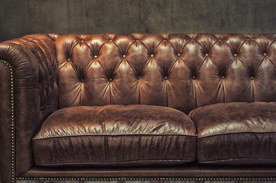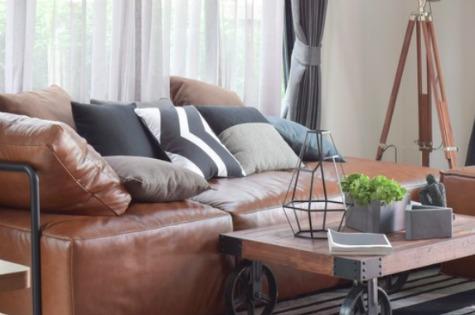Leather furniture is well-known for being hardy and durable, and it’s earned this reputation through hundreds of years of human usage of leather in many different applications. The reason we used it for armour in the middle ages was because it could withstand force and keep its wearer warm, an idea which eventually transferred to our furniture and other personal belongings.
When searching for sofas in Melbourne, leather is a great candidate for your material of choice because it will last a long time and you can plan your whole living room around it. To aid in the task of planning your living room around leather furniture, we’ve created this short article on this very topic.
Leather Types
The first thing to understand when it comes to leather furniture is that there are a few different kinds of leather, and each has it’s own benefits and drawbacks. Tanned leather, for instance, is resistant to stains, spills, physical damage and scuffs, but it cracks over time and can lose it’s colour if left in the wrong place.
Suede, on the other hand, will last longer when properly taken care of, but takes on spills, stains, and scuffs much more easily. Choosing your material for each piece of furniture should be based on the specific use of that furniture. For instance, a couch that gets used all the time is better off being suede, because it will weather the usage more gracefully than a harder, tanned leather.
Old
Once you understand the types of leather and what they’re good for, the next step is to decide whether you want to start with brand new furniture or go for older, antique furniture. For a lot of people this would be an easy choice, the older furniture is older and more likely to break, therefore the newer is clearly better.
This fails to take into account the quality of antique leather, and how well it has been cared for. Search for pieces that compliment the overall design of the room, instead of basing your decision on the age of the piece.
New
Newer leather might be more durable and more fresh than older material, but that doesn’t mean the older will age less gracefully. Older pieces can be made new again through a process called reupholstering, in which a skilled craftsperson will remove all the leather from a piece and replace it with new leather, essentially breathing new life into old bones. This is great if you find a piece with history or a great framework, but poorly cared-for casing.
Care
When it comes to caring for your piece, conditioning your leather regularly will ensure it stays soft and supple, and doesn’t crack or stretch in any way that could degrade the piece. Leather conditioner can be purchased from any furniture store that stocks leather items, or online from similar stores. Applying these things regularly, and keeping damp items of clothing or towels away from the surface will ensure it lasts for decades, instead of just years.
Quality
The quality of the build is important to the overall planning process as well.
 If you have found a heavy armchair that is solid as a rock, keeping it as a center point for your room is a good idea, as it’s less likely to shift around in day-to-day use. Look for high-quality wood in the construction of the furniture, and high quality leather in the upholstery, and you’ll have a brilliant centerpiece.
If you have found a heavy armchair that is solid as a rock, keeping it as a center point for your room is a good idea, as it’s less likely to shift around in day-to-day use. Look for high-quality wood in the construction of the furniture, and high quality leather in the upholstery, and you’ll have a brilliant centerpiece.
Purpose
Finally, finding the purpose of each piece is key, because it means you can plan for the amount of usage it will get. Fine, high-quality suede is lost on chairs that will see a lot of day-to-day use, because over time the suede will be marked and worn down. More rarely used items, however, are a better place for more expensive materials such as the aforementioned suede.
With these tips, you are ready to build you living room around pieces of furniture painstakingly selected by your own meticulous methods, and the end result will be divine.








 Agree (0)
Agree (0) Disagree (
Disagree (









__small.png)










